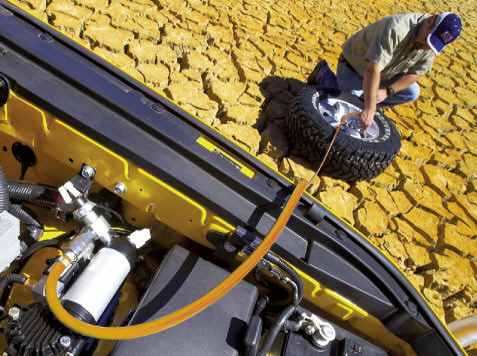Tires deflated
Bridgestone Study: The higher consumption if you tire deflated

In 2010, Bridgestone conducted a large study in nine countries. After the control of more than 38,000 cars, it was found that three quarters of drivers have tires deflated, which means two billion gallons of fuel brought down the drain annually.
How important is to have the tires inflated to nominal pressure? Extremely important, because several issues: road safety is improved, fuel consumption is reduced and tire wear is normal. However, the overwhelming majority of drivers in Europe do not pay attention to this "detail": the pressure in the tires.
In 2010, following the checks carried out on more than 38,000 cars in nine European countries, those from Bridgestone conducted a study on the consequences of using car tires deflated. Besides increasing the risk of accidents and premature tire wear, an important implication related to increased fuel consumption.
Thus, in 2010 concluded that 71% of European motorists driving cars with tires inflated or deflated in the normal range. Therefore, it was calculated that only last year was spent over 2 billion liters of fuel for nothing, and CO 2 emissions were 4.8 million tons more than if the tires were inflated to nominal pressure. This means about 2 g / km CO2 emissions per vehicle in Europe.
Doing a quick calculation at European level have been lost over 2.5 billion of that case - just because so many şoferil not realize that tires lose pressure over time, requiring swelling or even checking pressure regularly.
To better understand the effects of low tire pressure, should know that the tire air pressure has a great influence upon its rolling resistance. Basically, depending on driving conditions and driving style, rolling resistance tires and a car consumes between 18 and 26% of engine power. In translation, almost one fifth of the fuel tank is used only to counter resistance to rolling wheel!
Which, in the current fuel prices, means that if tires are not inflated to nominal pressure, simply spending money for nothing a few tens per liter of petrol or diesel - thus a full, this might throw down the drain a few lei, just because you have not inflated at nominal pressure wheels (see paragraph 3 of article "10 tips for economical driving).
Bridgestone engineers showed that 7.5% of drivers have lower tire pressures over 0.5 bar below the allowed limit, and 0.5% of drivers had tire pressure more than 0.75 bar lower than the normal , which drastically increases the risk of accidents. For example, in wet conditions, a tire blew out will lead to the phenomenon of aquaplaning (wheel slippage on the surface film of water) at a rate 40% lower - so the wheels deflated, you risk losing control of car in rain even at 50-60 km / h.
Experts recommend checking as often Bridgestone tire pressure, which leads, in addition to a pretty significant savings in their pockets, and reduce pollution. They also recommended drivers to choose the new range of eco-tires tire manufacturers (for example, offers new family of tires Bridgestone Ecopia), while recommending authorities to take severe measures against those with deflated tires - a first step was done in this respect by the European Commission, which wants the introduction of mass production system tire pressure monitoring.
.
HOW OFTEN YOU check your tire pressure?
Answers and comments














